 |
New York Architecture Images- Lower Manhattan FEDERAL HALL NATIONAL MEMORIAL Landmark |
|||
|
architect |
Ithiel Town and Alexander Jackson Davis (interior by John Frazee and Samuel Thompson) | |||
|
location |
Wall St. | |||
|
date |
1833-42 | |||
|
style |
Greek Revival | |||
|
construction |
stone | |||
|
type |
Government | |||
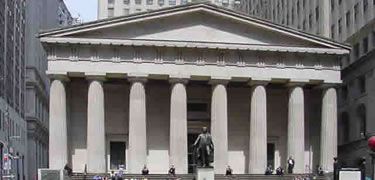 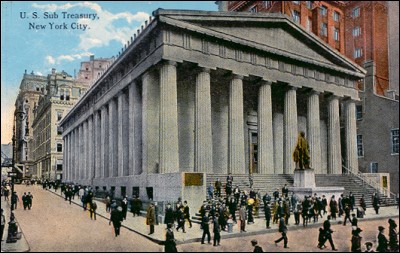 |
||||
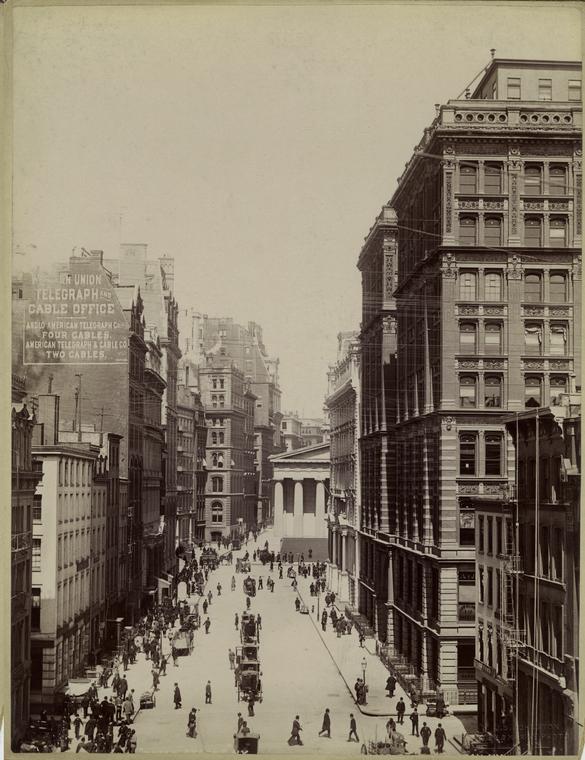 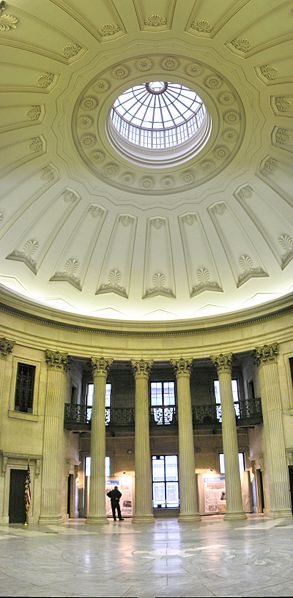 |
||||
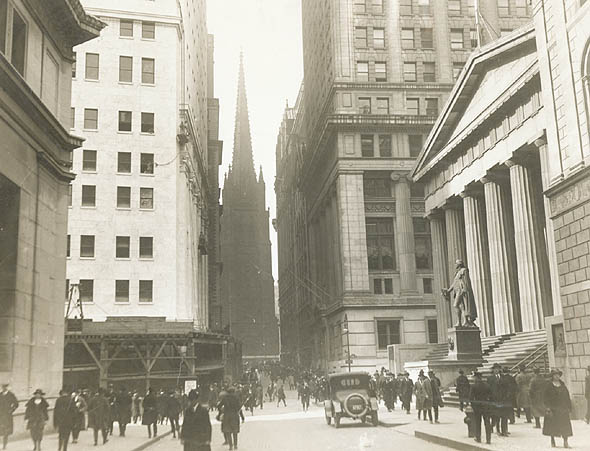
|
||||
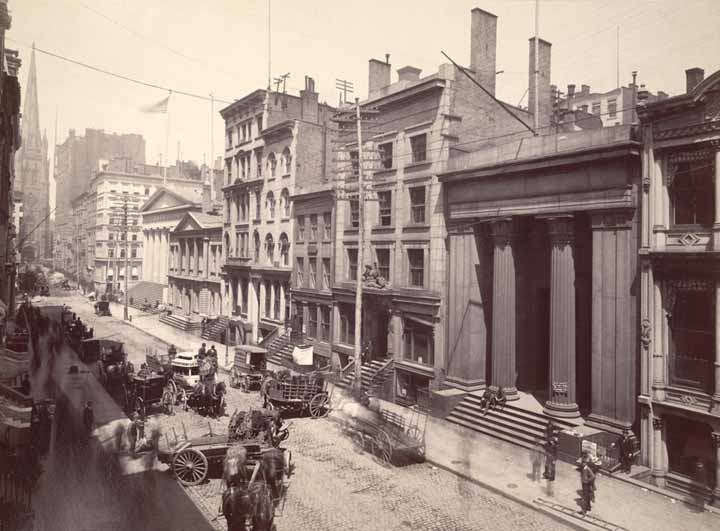 |
||||
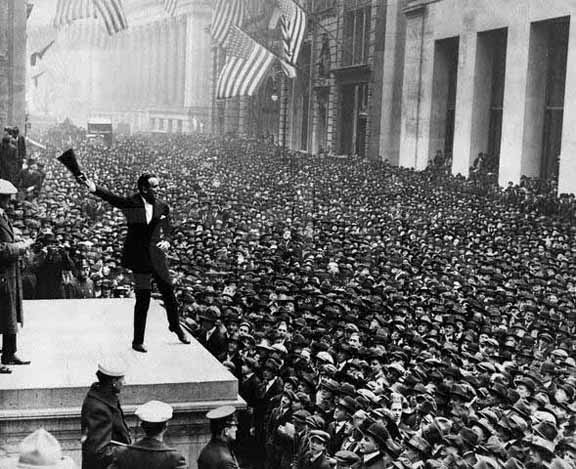 |
||||
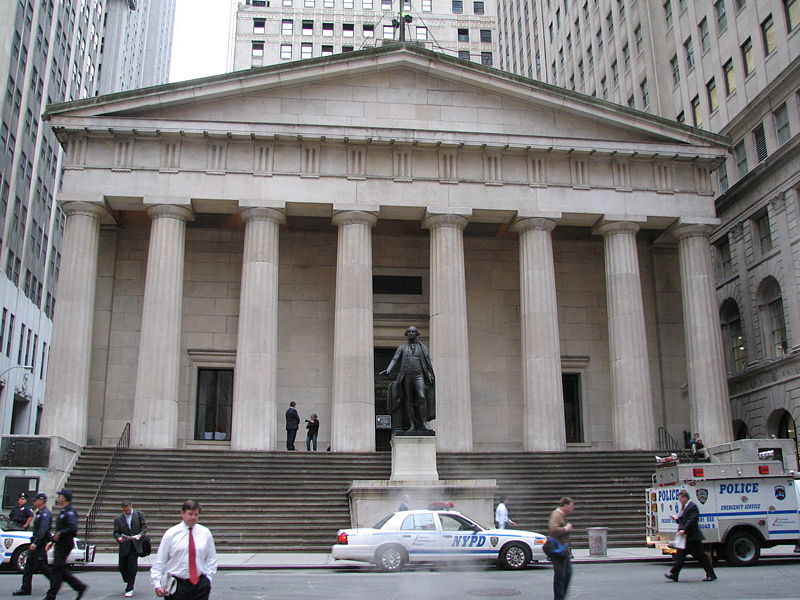 |
||||
.jpg) |
||||
| Etching of Old City Hall, 1789 | ||||
.jpg) .jpg) |
||||
| The old Federal Hall, etching from before 1812 and US President George W. Bush delivers remarks on the economy in Federal Hall, Jan. 31, 2007. | ||||
|
|
     |
|||
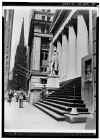   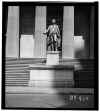 |
||||
 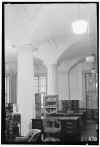 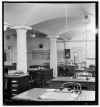   |
||||
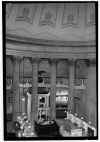 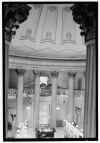 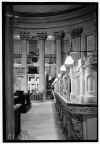 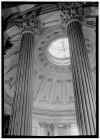 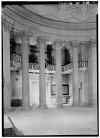 |
||||
 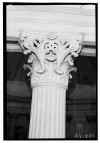 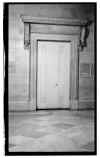 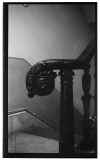 |
||||
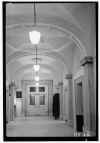 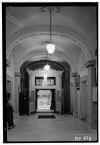 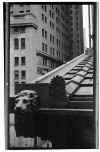 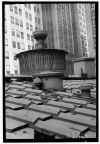    |
||||
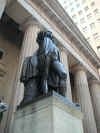 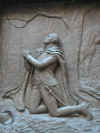  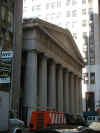 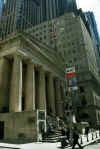 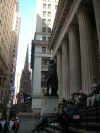 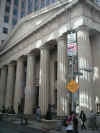 |
||||
|
images |
  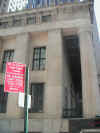 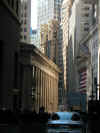 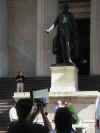 |
|||
|
|
||||
|
Built to replace the old City Hall on the same
site, it was here that George Washington was inaugurated as President.
The building was dishonored and torn down within fifteen years and
rebuilt as the new Customs House. When customs functions grew and a
grander building was needed, a new, democratic Greek Revival appearing
Customs House was built in 1836 with a temple front symbolizing the
democratic ideals of the young country. This structure proved too small
for Customs House operations, and was converted into a sub-treasury in
the 1920s until the present Federal Reserve Bank was opened. It is
currently a national monument and a tourist site in lower Manhattan.
Federal Hall has been the site of government activity for almost 300 years. Three successive buildings have stood at the corner of Wall and Nassau streets, each playing a role in momentous national historic events. The earliest, started in 1699 and completed in 1702, was New York's third City Hall. This is where John Peter Zenger was tried and acquitted of seditious libel in 1735, marking the country's first great 'freedom of the press' trial. In 1765, the Stamp Act Congress met to protest English taxation, and resistance to "taxation without representation" spread across America. Six years after the Revolutionary War, New York City became the first capital city of the United States. In 1789 old City Hall was renovated and renamed Federal Hall, becoming the young nation's first Capitol building. On March 4 of that year the government of the United States of America began to function there under the present constitution. Eight weeks later George Washington, standing on an open-air balcony on the second floor, took the oath of office to become the nation's first President. Today's Supreme Court and the Departments of State, Defense and the Treasury can trace their beginnings to Federal Hall. In 1812, after the seat of government moved south, this second structure was razed and sold for scrap, fetching $425. The present building, an excellent example of Greek Revival architecture, was constructed in 1842 as a custom house. The Independent Treasury System was established here in 1862 and the Federal Reserve System in 1913. In 1939 the Secretary of the Interior declared the structure a National Historic Shrine. In 1955 Congress renamed it Federal Hall National Memorial in honor of the earlier edifice. There are guided tours, and the second-floor galleries mount temporary exhibitions for all ages. These shows, which are organized by other galleries and museums, have included a New York City/Tokyo exchange show of children's art, a pictorial display of the city boroughs and a Smithsonian exhibit about everyday life in Colonial America. General Information Hours: Monday-Friday 9 am-5 pm; closed
Saturday, Sunday |
||||
|
notes |
|
|||
|
New York Times March 18, 2004 Federal Hall Is Uplifted, First by Steel, Then by Art By DAVID W. DUNLAP Birthplace of the Republic. Cynosure of Wall Street. Cradle of the Renaissance? Federal Hall National Memorial marks the spot on which George Washington was inaugurated. It sheltered 300 people on Sept. 11, 2001, an event that literally shook the building to its foundation. And more recently, it has provided a civic forum for World Trade Center plans and designs. Beginning in October, it will also become the downtown branch of the Uffizi. As part of the Splendor of Florence festival that is to be staged throughout Lower Manhattan, the Uffizi Gallery will lend 22 paintings from the 16th and 17th centuries. All but one will be portraits of the Medici family. The lone exception and star of the show - perhaps set by itself in the column-bordered rotunda of Federal Hall - will be the newly restored "Madonna della Gatta," by Federico Barocci. "I believe this is the blockbuster that will open peoples' eyes to the glory of Federal Hall," said Debra Simon, executive director of the arts and events program at the World Financial Center at Battery Park City. The center's principal owner, Brookfield Properties, is a sponsor and host of the festival. Federal Hall, a 162-year-old Greek Revival landmark at Wall and Broad Streets, is undergoing a renaissance of its own. Last summer, a dangerously undermined corner was shored up. Later this year, two other corners and part of the east wall will be shored up. Cracks will be stabilized and patched. And a new heating, ventilating and air-conditioning system will be installed. The $16 million rehabilitation can be traced directly to the attack on New York. "We have severe cracks in the infrastructure, which had existed prior to 9/11, but 9/11 exacerbated the cracking" of interior and exterior walls, said Joseph T. Avery, superintendent of Manhattan sites for the National Park Service, which runs Federal Hall. One of those fissures, in a basement storage room, had grown ominously in the wake of the attack. "What had been a pinhole was big enough that you could put your thumb in," Mr. Avery recalled. The park service called in the architectural and engineering firm Einhorn Yaffee Prescott. One of the attention-grabbing exterior cracks was at the corner near Pine Street. Formerly a hairline, it was now closer to a quarter-inch wide. "It seems to have been the seismic event of the collapses that triggered the cracking," said Marie Ennis, an engineer and the firm's principal in charge of the project. Because the building is rigid masonry and is surrounded by subway and utility lines, it had been threatened by vibrations and settling soil for many decades. Indeed, the rumbling of passing trains can be felt through the hall. Ms. Ennis said the investigation of attack-related damage afforded the chance "to figure out, once and for all, what all the problems were at Federal Hall." Working with Langan Engineering and Environmental Services, the architects brought in ground-penetrating radar. What they found at one corner shocked them. "There was no soil, but 24 inches of air, under one of the columns," Ms. Ennis recalled. "I lost a lot of sleep when we found that air void." The solution was to insert four steel pilings about 60 feet deep down to rock. The next round of underpinnings will take the form of mini-caissons made of a concretelike grout that is injected in cavities drilled by a special rig. "Once that's done, we'll work our way up the building," Ms. Ennis said. Parts of the marble facade may be cleaned. Depending on conditions, the project is expected to take about a year. At times, Federal Hall may have to be closed to the public. Built on the site of the Federal Hall in which Washington was inaugurated, the current building served originally as the Custom House and then as the United States Sub-Treasury. The Lower Manhattan Development Corporation has used it in recent years to unveil plans for the overall trade center site, as well as the final designs for the Freedom Tower and the "Reflecting Absence" memorial. "It has, in many ways, re-established itself as the center of Lower Manhattan," said Kevin M. Rampe, president of the development corporation, which contributed $250,000 toward the $1.2 million cost of the festival. As for day-to-day events at Federal Hall, a treasure that many New Yorkers still manage to overlook, Mr. Avery said, "We're thinking about a broad range of enhancements and a broadening of programs." The park service, he said, is searching for a curator "because we'd like to fill the place" with exhibitions. For six weeks this fall, that will not be a problem. Twenty-two paintings from the Uffizi will go on view on Oct. 1 and remain until Nov. 15. "We consider this an extraordinary event, because the Uffizi doesn't lend easily," said Ms. Simon of the World Financial Center. The centerpiece of the loan is a sweet and tender work by Barocci, who died in 1612, having "enjoyed a greater popularity and exerted a more profound influence on the art of his time than any of his contemporaries," said The Dictionary of Art (Grove, 1996). In the painting, a very sleepy-eyed infant Jesus is being rocked in a cradle by Mary. Within the folds of her robe, a mother cat nurses a kitten. Joseph stands before them at left. On the right is the young John the Baptist, with his parents, Elizabeth and Zachary. Other works coming from the Uffizi include portraits of members of the Medici family by Frans Pourbus the Younger, Justus Sustermans and Tiberio Titi. The Medici portraits are meant to emphasize the tradition of art patronage and craftsmanship in the Splendor of Florence festival, which will run for 10 days beginning Oct. 1. Seven artisans - ceramicists, carvers, jewelers, lacemakers - will set up shop around the Winter Garden, in the World Financial Center, with exhibits and demonstrations. There will be tastings of Tuscan food, performances, concerts and a series of films set in Florence. The festival, founded by Joyce Acciaioli Rudge, was first presented in Providence, R.I., in 1999 and then in Philadelphia in 2001, an event delayed by the Sept. 11 attacks. Fund-raising for the New York festival is about $200,000 shy of the final goal, Ms. Simon said, an amount that corresponds roughly to the cost of shipping, insuring and guarding the paintings. That works out to $10,000 each and sponsors are being sought to adopt the artworks. "It's a wonderful, specific thing that people can do," Ms. Simon said. "Someone can say, 'I brought that painting over.' " |
||||
|
Federal Hall, once located at 26 Wall Street in New York City, was the
first capitol of the United States. The building was demolished in the
19th century and replaced by the current structure, the first United
States Customs House. The building is now operated by the National Park
Service as the Federal Hall National Memorial, a museum that
commemorates the earlier structure. Historic building J.Q.A. Ward's statue of George Washington in front of Federal Hall, on the site where Washington was inaugurated as the first U.S. President. The original structure on the site was built as New York's City Hall in 1700. In 1735, John Peter Zenger, an American newspaper publisher, was arrested for committing libel against the British royal governor and was imprisoned and tried there. His acquittal on the grounds that the material he had printed was true established the freedom of the press as it was later defined in the Bill of Rights. In October 1765, delegates from nine of the 13 colonies met as the Stamp Act Congress in response to the levying of the Stamp Act by the Parliament of Great Britain. Drawn together for the first time in organized opposition to British policy, the attendees drafted a message to King George III, the House of Lords, and the House of Commons, claiming entitlement to the same rights as the residents of Britain and protesting the colonies' "taxation without representation." The building was remodelled and enlarged following the American Revolution under the direction of Pierre Charles L'Enfant, who was later selected by President Washington to design the capital city on the Potomac. This was the first example of Federal Style architecture in the United States. It was renamed Federal Hall when it became the first Capitol of the United States under the Constitution in 1789, and was the second Capitol of the United States (after the Maryland State House) since independence and union under the Articles of Confederation. The first United States Congress met there on March 4, 1789, to establish the new federal government, and the first thing they did was count the votes that elected George Washington as the first President of the United States. He was inaugurated in front of the building on April 30, 1789. Many of the most important legislative actions in the United States occurred with the 1st Congress at Federal Hall. First among these were adoption of the Bill of Rights to the U.S. Constitution; not long after the new federal Constitution was ratified, many Americans began to express their concern for its limited protection of individual liberties. Twelve amendments to the Constitution were initially drafted, ten were agreed upon, and on September 25, 1789, the Bill of Rights was adopted in Federal Hall, establishing the freedoms claimed by the Stamp Act Congress on the same site 24 years earlier. Also, the Judiciary Act of 1789 was enacted in the building which set up the United States Court System, which is still in use today. In addition, The Northwest Ordinance was adopted at Federal Hall which set up what would later become the states of Ohio, Indiana, Illinois, Michigan and Wisconsin, but more fundamentally it prohibited slavery in these future states. In 1809, several city notables, including Clement Clarke Moore, were convened there by the New-York Historical Society to declare Sancte Claus the Patron Saint of Nieuw Amsterdam, New York City's previous name under Dutch rule. Sancte Claus, today's Santa Claus, is the English version of the Dutch Christmas hero Sinter Claus or Saint Nicholas who helped young people in Asia Minor. These notables, including the poet of the famous early Christmas poem, 'A Visit From St. Nicholas,' assembled to create a more unified and peaceful way to celebrate Christmas in a rapidly growing and diverse town. In 1812 the old New York City Hall, known as Federal Hall, was torn down for $400 worth of scrap. Part of the original railing and balcony floor where Washington was inaugurated are on display in the monument. Current structure In 1790, the United States capital was moved to Philadelphia and what had been Federal Hall once again housed New York City government until 1812, when the building was razed. The current structure, one of the best surviving examples of classical architecture in New York, was built as the country's first Customs House, opening in 1842, and later served as one of six United States Sub-Treasury locations and a Federal Reserve Bank. Two prominent American ideals are reflected in the building's architecture: The Doric columns of the façade, designed by Ithiel Town and Alexander Jackson Davis, resemble those of the Parthenon and serve as a tribute to Greek democracy; the domed ceiling inside, designed by John Frazee, echoes the Pantheon and the economic might of the Romans. The current structure is often overshadowed among downtown landmarks by the New York Stock Exchange, which is located diagonally across Wall and Nassau Streets, but the site is one of the most important in the history of the United States and, particularly, the foundation of the United States Government and its democratic institutions. The current building is well-known for the bronze statue of George Washington on its front steps, marking the site where he was inaugurated as US President in the former structure. In 1920, a bomb was detonated across the street from Federal Hall at 23 Wall Street, in what became known as the Wall Street bombing. 38 people were killed and 400 injured, and 23 Wall was visibly damaged, but Federal Hall received no damage. A famous photograph of the event shows the destruction and effects of the bombing, but also shows the statue of Washington standing stoically in the face of chaos. Federal Hall National Memorial The building was designated as Federal Hall Memorial National Historic Site on May 26, 1939, and redesignated a national memorial on August 11, 1955. As with all historic areas administered by the National Park Service, the memorial was listed on the National Register of Historic Places on October 15, 1966. The National Park Services operates Federal Hall as a museum. The museum closed on December 3, 2004 for extensive renovations and reopened in the fall of 2006. Normally its exhibit galleries are open free to the public daily, except national holidays, and guided tours of the site are offered throughout the day. Exhibits include: George Washington’s Inauguration Gallery - Including the Bible used to swear his oath of office. Freedom of the Press - The imprisonment and trial of John Peter Zenger. Journey to Federal Hall - An 8-minute video about the history of Federal Hall. On September 6, 2002, approximately 300 members of the United States Congress traveled from Washington, D.C. to New York to convene in Federal Hall as a symbolic show of support for the City, still recovering from the September 11, 2001 attacks. Just four blocks from Ground Zero, the meeting was the first by Congress in New York since 1790. In 2006, Federal Hall opened after a brief closure and a $16 million renovation, mostly to its foundation, after cracks threatening the structure were greatly aggravated by the collapse of the World Trade Center Twin Towers. As a national monument, the site is open free to the public from 9-5 on week days. It has tourist information about the New York Harbor Area's Federal monuments and parks, and a New York City tourism information center. The gift shop has colonial and early American items for sale. Cultural references Federal Hall has appeared in several movies as well as Rage Against the Machine's music video for Sleep Now in the Fire featuring Michael Moore. In the video game Metal Gear Solid 2: Sons of Liberty, the final scene of the game takes place at Federal Hall, after Arsenal Gear crashes through Manhattan and stops at Federal Hall, damaging the right side of the structure. References The National Parks: Index 2001–2003. Washington: U.S. Department of the Interior. |
||||